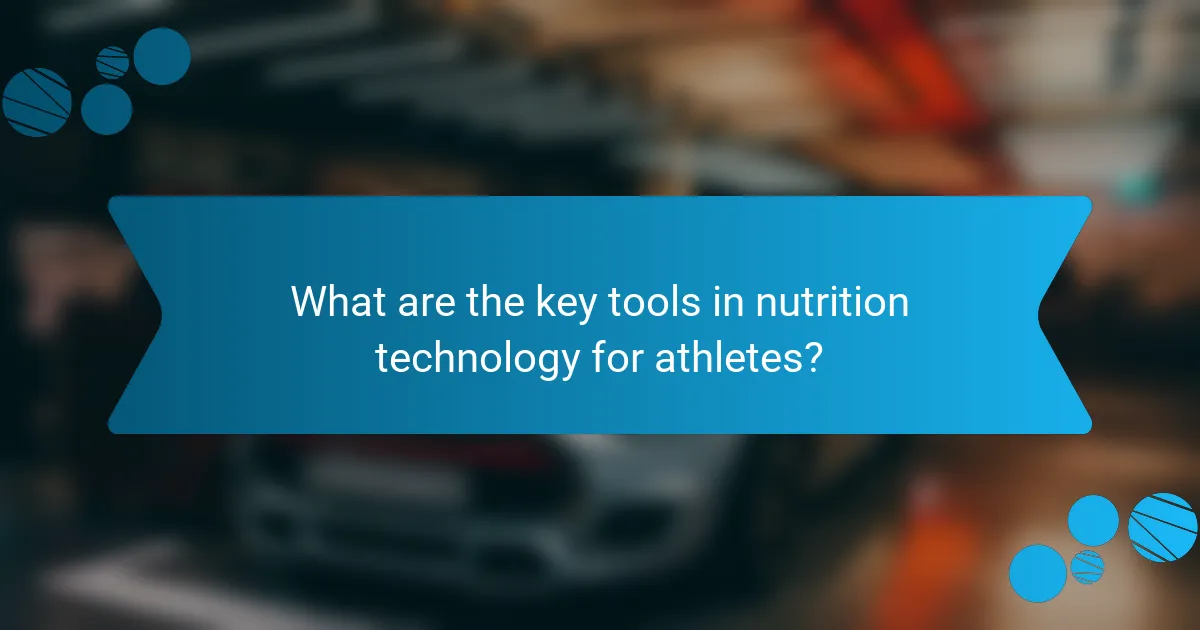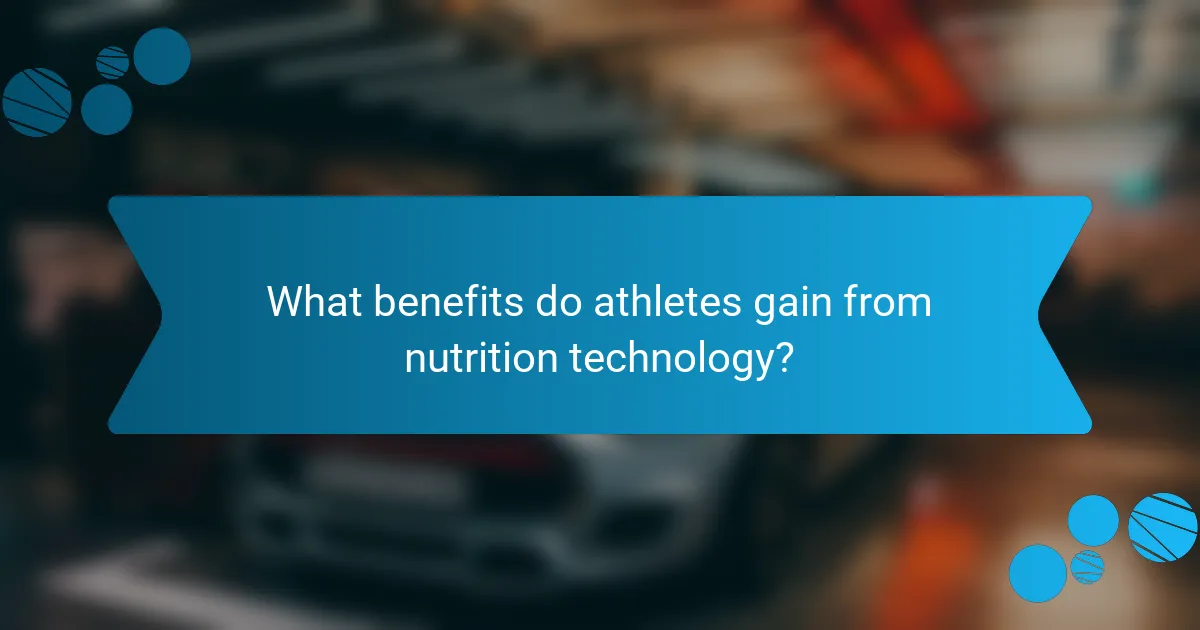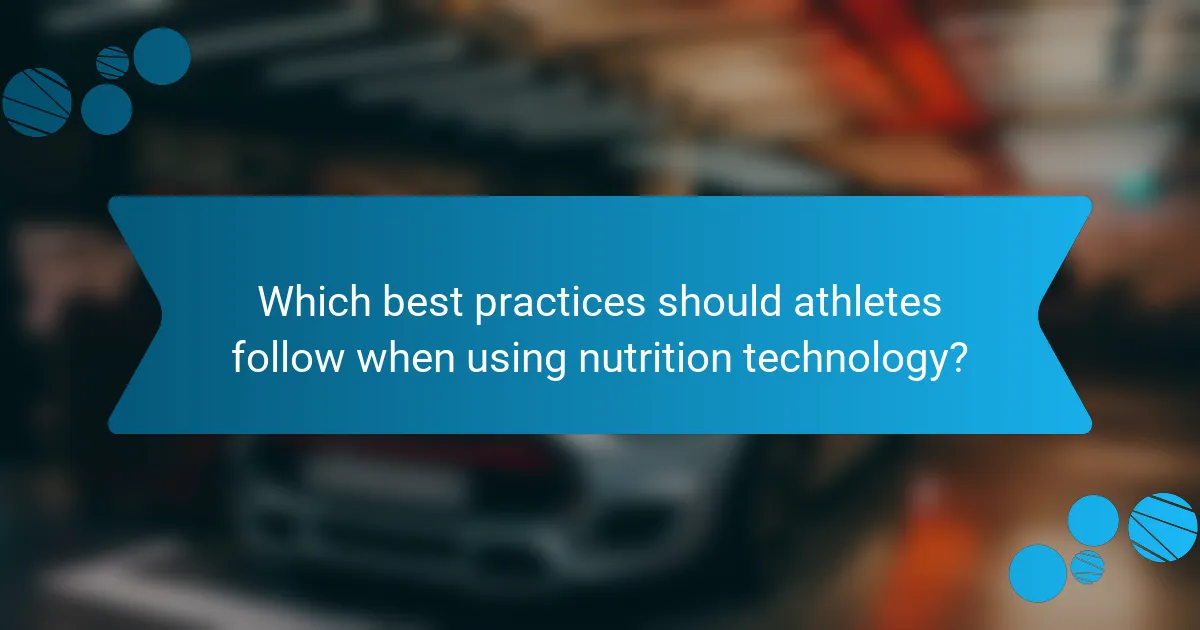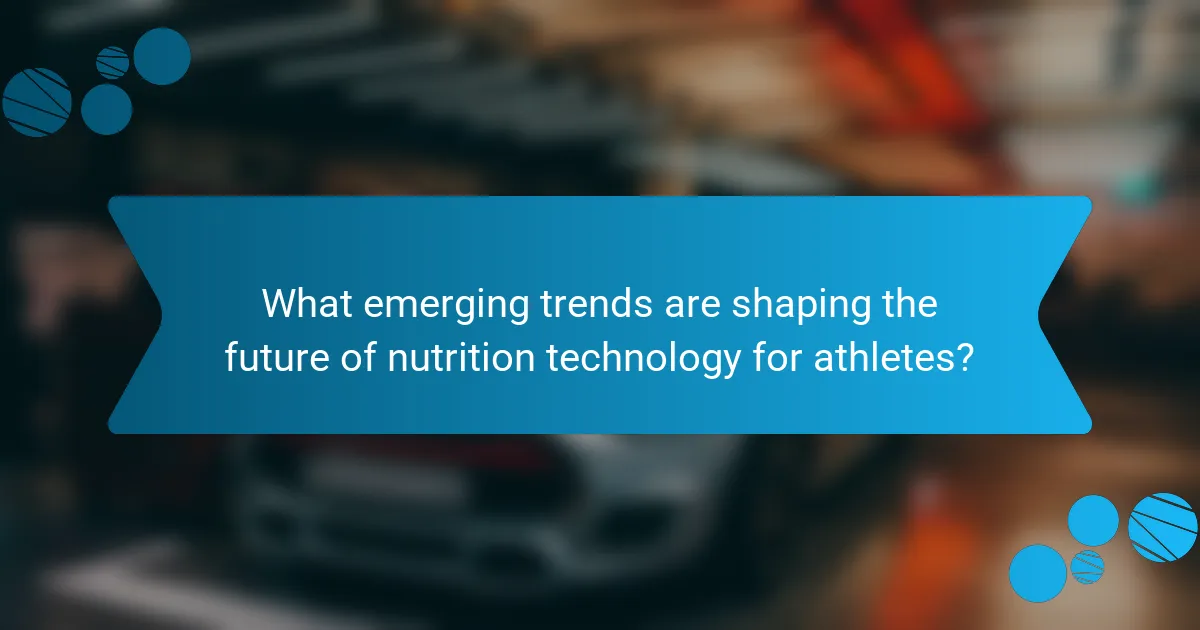Nutrition technology empowers athletes to enhance performance and recovery through personalised dietary strategies. Key tools include wearable devices, mobile apps, and data analytics platforms. These technologies facilitate real-time monitoring, nutrient analysis, and tailored meal planning. Emerging trends focus on personalised nutrition and AI-driven meal adjustments, ensuring athletes meet their unique energy and recovery needs.

What are the key tools in nutrition technology for athletes?
Key tools in nutrition technology for athletes include wearable devices, mobile applications, and data analytics platforms. These tools help optimise performance through personalised nutrition plans, real-time monitoring, and dietary analysis. Wearable devices track biometrics like heart rate and activity levels, while apps provide meal tracking and nutrient analysis. Data analytics platforms aggregate this information to offer insights into dietary habits and performance outcomes. These technologies enable athletes to make informed dietary choices, enhancing recovery and overall performance.
How do wearable devices enhance nutritional tracking?
Wearable devices enhance nutritional tracking by providing real-time data on dietary intake and physical activity. They help athletes monitor macronutrient consumption and hydration levels accurately. This technology improves performance by offering personalised insights based on individual goals and metabolic rates. As a result, athletes can make informed dietary choices to optimise their training and recovery.
Which apps are most effective for meal planning and monitoring?
MyFitnessPal, Lose It!, and Cronometer are among the most effective apps for meal planning and monitoring. These applications offer comprehensive features for tracking nutrition and performance.
MyFitnessPal provides a vast food database, allowing users to log meals easily. It also offers personalised goals based on individual dietary needs. Lose It! focuses on simplicity and user-friendly interfaces, making it easy to set calorie goals and track progress. Cronometer stands out with its detailed nutrient tracking, catering to athletes who need precise data on micronutrients.
These tools enhance nutritional awareness, support dietary adherence, and optimise performance for athletes.
What role do smart kitchen appliances play in athlete nutrition?
Smart kitchen appliances enhance athlete nutrition by streamlining meal preparation, ensuring portion control, and improving food quality. These devices utilise technology to automate cooking processes, making it easier for athletes to maintain balanced diets.
For instance, smart blenders can create nutrient-dense smoothies quickly, while smart ovens can optimise cooking times and temperatures for various foods. This technology supports athletes in meeting their nutritional goals efficiently, saving time and effort.
Additionally, smart appliances often integrate with apps that track dietary intake, providing valuable insights into macronutrient distribution. This data helps athletes make informed decisions about their meals, aligning with their performance needs.
Overall, the role of smart kitchen appliances in athlete nutrition is significant, promoting convenience, consistency, and quality in food preparation.
How is data analytics transforming nutrition strategies for athletes?
Data analytics is revolutionising nutrition strategies for athletes by providing personalised insights. Athletes can optimise their diets based on real-time data, enhancing performance and recovery. Advanced analytics tools assess individual nutritional needs, monitor dietary intake, and analyse the impact of food on performance metrics. This data-driven approach allows for tailored meal plans that align with training regimens and competition schedules. As a result, athletes experience improved energy levels, faster recovery times, and better overall health.

What benefits do athletes gain from nutrition technology?
Athletes gain improved performance, recovery, and personalised nutrition plans from nutrition technology. These tools analyse dietary habits, track nutrient intake, and optimise meal timing. For example, wearable devices monitor hydration levels and energy expenditure, enhancing training outcomes. Additionally, apps provide tailored meal suggestions based on individual goals, ensuring athletes meet their nutritional needs effectively.
How does technology improve nutrient absorption and performance?
Technology enhances nutrient absorption and performance by optimising dietary intake and tracking physiological responses. Advanced tools like wearable devices monitor hydration and nutrient levels, ensuring athletes meet their specific needs. Nutritional apps provide personalised meal plans based on individual goals and preferences. Additionally, smart supplements use bioavailability technology to increase nutrient uptake, maximising benefits. This integration of technology allows for real-time adjustments, improving overall athletic performance.
What impact does personalised nutrition have on recovery times?
Personalised nutrition can significantly reduce recovery times for athletes. Tailored dietary plans optimise nutrient intake, addressing individual needs and enhancing recovery processes.
Studies indicate that athletes who follow personalised nutrition protocols experience faster muscle repair and reduced inflammation. For instance, customised protein intake can lead to improved muscle synthesis, while specific carbohydrate timing can replenish glycogen stores more efficiently.
Additionally, incorporating specific vitamins and minerals based on individual deficiencies can further enhance recovery. This targeted approach ensures athletes receive the necessary support for their unique physiological demands.
Why is real-time feedback crucial for athlete nutrition management?
Real-time feedback is essential for athlete nutrition management as it allows for immediate adjustments to dietary plans based on performance and recovery needs. This responsiveness enhances nutrient timing, ensuring athletes receive optimal energy and recovery support. Moreover, technology tools can track macronutrient intake and hydration levels, enabling personalised nutrition strategies that adapt to training intensity and goals. By leveraging real-time data, athletes can improve their performance outcomes and overall health.

Which best practices should athletes follow when using nutrition technology?
Athletes should prioritise accuracy, consistency, and integration when using nutrition technology. First, they should select reliable tools that provide precise data on macronutrient intake. Consistently tracking nutrition habits enhances performance insights. Finally, integrating technology with personal training and recovery plans maximises benefits.
How can athletes effectively integrate technology into their daily routines?
Athletes can effectively integrate technology into their daily routines by using nutrition apps, wearables, and data analytics tools. These technologies help track dietary intake, monitor hydration, and optimise performance.
Nutrition apps provide personalised meal plans based on individual goals, while wearables track biometrics like heart rate and calorie expenditure. Data analytics tools analyse performance metrics to identify areas for improvement.
By leveraging these technologies, athletes can enhance their training efficiency and achieve better results. Regularly updating their tech tools ensures they stay aligned with their evolving nutritional needs.
What common mistakes do athletes make with nutrition technology?
Athletes often make mistakes with nutrition technology by relying too heavily on data without understanding its context. Common errors include misinterpreting nutritional metrics, neglecting individual needs, and overcomplicating meal planning. These issues can lead to poor dietary choices and hinder performance. For example, athletes may prioritise macronutrient ratios based on generalised data rather than personal requirements, resulting in ineffective nutrition strategies. Additionally, failing to integrate technology with practical eating habits can diminish the benefits of these tools.
Which metrics should athletes prioritise for optimal nutrition tracking?
Athletes should prioritise metrics like macronutrient intake, hydration levels, meal timing, and micronutrient balance for optimal nutrition tracking. These metrics directly influence performance and recovery.
| Metric | Importance | Recommended Value |
|———————-|———————————|—————————|
| Macronutrient Intake | Supports energy and recovery | 50-60% carbohydrates |
| Hydration Levels | Prevents dehydration and fatigue | 3-4 litres daily |
| Meal Timing | Enhances nutrient absorption | Pre- and post-workout |
| Micronutrient Balance| Aids overall health and performance| Daily values per nutrient |

How does nutrition technology vary across different sports disciplines?
Nutrition technology varies significantly across sports disciplines, tailored to the unique demands of each sport. For endurance sports, tools focus on optimising energy intake and hydration, utilising wearables that track biometrics. In strength sports, technology emphasises muscle recovery and nutrient timing, often incorporating advanced supplements and meal planning apps. Team sports leverage performance analytics and diet monitoring to enhance overall athlete health and performance. Individual sports may prioritise personalised nutrition plans based on specific metabolic needs. The integration of technology in nutrition helps athletes maximise performance through data-driven insights and tailored dietary strategies.
What unique nutritional challenges do endurance athletes face?
Endurance athletes face unique nutritional challenges, including higher energy demands and specific macronutrient needs. They require increased carbohydrates for sustained energy, protein for muscle repair, and adequate hydration to prevent fatigue. Micronutrient deficiencies can also occur due to intense training regimens. As a result, utilising nutrition technology can help track intake and optimise performance.
How do team sports leverage nutrition technology differently?
Team sports leverage nutrition technology through tailored dietary strategies, real-time monitoring, and data analytics. These tools enhance performance by optimising individual and team nutrition plans based on specific needs. For instance, sports teams utilise wearable devices to track athletes’ biometrics, which informs dietary adjustments. Additionally, software platforms analyse nutritional intake, ensuring athletes meet their energy requirements. This data-driven approach contrasts with individual sports, where personal preferences may dominate nutritional strategies. Overall, team sports benefit from a collaborative framework that integrates nutrition technology for improved performance outcomes.

What emerging trends are shaping the future of nutrition technology for athletes?
Emerging trends in nutrition technology for athletes include personalised nutrition, wearable tech for real-time data, and AI-driven meal planning. These innovations enhance performance, optimise recovery, and tailor diets to individual needs. Personalised nutrition leverages genetic and metabolic data to create customised dietary plans, improving nutrient absorption. Wearable devices track biometrics, helping athletes adjust their nutrition based on real-time physiological feedback. AI tools analyse performance data and suggest meal adjustments, ensuring athletes meet their specific energy and recovery requirements. These trends signify a shift towards data-driven, individualised approaches in athletic nutrition.
How are advancements in AI influencing personalised nutrition plans?
Advancements in AI are revolutionising personalised nutrition plans by providing tailored recommendations based on individual data. AI analyses factors like metabolism, activity levels, and dietary preferences to create optimised meal plans. This technology enhances athletes’ performance by ensuring they receive the right nutrients at the right times. Additionally, AI-driven apps can track progress and adjust plans dynamically, making nutrition strategies more effective and responsive. Overall, integrating AI into nutrition technology empowers athletes with customised solutions that align with their unique needs.
What role does virtual reality play in athlete nutrition training?
Virtual reality enhances athlete nutrition training by providing immersive, interactive experiences that simulate real-life scenarios. This technology aids in visualising meal planning, understanding nutrient timing, and practising portion control. Athletes can engage in realistic training environments that reinforce nutritional strategies, leading to better adherence and performance outcomes. Additionally, virtual reality can track progress and offer personalised feedback, making it a unique tool in optimising athlete nutrition.
How are sustainability practices impacting nutrition technology for athletes?
Sustainability practices are significantly enhancing nutrition technology for athletes by promoting eco-friendly sourcing and reducing waste. These practices encourage the development of innovative tools that optimise nutrient delivery and minimise environmental impact. For example, plant-based supplements are gaining traction, providing athletes with effective nutrition while supporting sustainable agriculture. Additionally, technologies that track carbon footprints of food products help athletes make informed choices that align with their performance and environmental values. This integration of sustainability into nutrition technology not only benefits athletes’ health but also contributes to a more sustainable food system.
What are the best strategies for optimising nutrition technology use?
To optimise nutrition technology use for athletes, focus on personalised data analysis and real-time feedback. Leverage tools that track macronutrient intake and hydration levels. Implement wearable devices for monitoring performance metrics. Collaborate with nutritionists to create tailored meal plans. Regularly assess and adjust strategies based on performance outcomes.